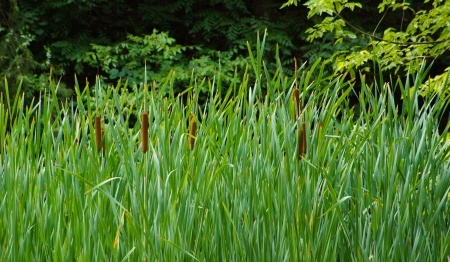Sweet Flag - Acorus calamus

Common Names: Sweet Flag, Rat Root, Calamus, Acorus, Acorus calamus, Acorus verus, Flagroot, Bach Root, Growing Rush, Myrtle Flag, German ginger, Myrtle grass, Tatar-calamus, Indian Calamus, Bhut jhar, Tatar herb, Water acorus, Flag, Scented rush, Marsh calamus, Aromatic flag, Calamus root, Acori calami rhizoma, European calamus, Chinese rhubarb, Szent tritina, Pravni akorus, Bruškvorec, Prsni koren, Prskořen, Pískacky
Latin Name: Acorus calamus
Origin: Asia, Europe, South America, North America
Short Introduction
Sweet Flag is easy and rewarding to cultivate, though it is becoming increasingly rare in the wild. It thrives around small artificial ponds and grows well from a piece of rhizome with a leaf bud. Sweet Flag can be planted freely or in pots of soil in wetlands, glass containers, aquaria, or directly into the pond.
The rhizome is harvested in November or early spring without leaves or roots (Rhizoma calami). Clean it thoroughly, cut into pieces 20–35 cm long, split lengthwise, and dry unpeeled at 40°C. Properly dried rhizome is highly aromatic, bitter, brittle, and has a reddish-brown color with gray hues. Its quality lasts about a year and a half before declining. The best material comes from two- to three-year-old plants.
Detailed Description
Sweet Flag is a traditional herbal remedy valued for stimulating appetite, supporting healthy digestion, and providing potential relief for rheumatism.
Botanical Information
Sweet Flag (Acorus calamus) is a perennial, aromatic herb growing up to 1.5 meters tall. Its stem is triangular, often reddish at the base, with a fleshy, branched, creeping rhizome that is yellow-green, up to 3 cm thick and about 50 cm long, white in cross-section, and spongy in texture.
The leaves of Sweet Flag are narrow, tough, grass-like, and sword-shaped—up to 2 cm wide with undulated edges. Its flowers are tiny, yellow-green or just green, arranged in slender spike inflorescences. Flowering takes place from June to July. The fruit is a red berry, but in temperate climates such as Central Europe, the plant cannot produce viable fruit and thus spreads only vegetatively.
Origin and Distribution
Sweet Flag is believed to have originated from Eastern India and China, particularly South China, spreading through India further afield. Today, it is found across almost all of Europe, Asia, and North America. It is not native to the Czech Republic—it was introduced in the 16th century (earlier to some parts of Europe via the Tatars). Within Central Europe, it grows scattered across wetlands—muddy ponds, river arms, marshes, and still waters. Due to human impact on these natural habitats, Sweet Flag is becoming increasingly rare in the wild.
Usage / Dosage
One of the earliest records of Sweet Flag dates to around 1300 BCE in Egyptian papyri, where it was combined with other herbs in compresses to alleviate abdominal pain or used in the making of perfumes. During the Middle Ages, Europeans confused Sweet Flag with Iris, another medicinal plant of antiquity. Herbals from Mainz (1485) and France (P. Treveris, 1526) reference "Acorus" as an iris-type plant. By the late 16th century, Sweet Flag reached Britain, where John Gerard cultivated and described it as "Acorus verus."
In pharmacy and folk medicine, the dried rhizome (Rhizoma calami aromatici) is the primary part used. It is traditionally applied as a stomachic to promote gastric juice and digestion, calm spasmodic cramps in the GI tract, and aid in the metabolism of hard-to-digest foods. Sweet Flag is an ingredient in bitters, stomach drops (Swedish Bitters), and in history, liqueurs supporting digestion. As a spice, Sweet Flag powder is used in Indian and Islamic cuisines for sweets, candied in the US, and young shoots are eaten as salad to enhance appetite. Regulatory bodies recognize Sweet Flag as a herb that contributes to optimal digestive health and promotes internal balance.
Folk herbalists recommend Sweet Flag infusions as a mild sedative, antidepressant, antispasmodic, anti-asthmatic, to support diuresis, and as a mood booster for people recovering from surgery, the elderly, or the ill. It is attributed with easing allergies, providing external remedies for rheumatism, eczema, poorly healing wounds, and is sometimes used as a general tonic. The root’s compounds have been shown to refresh the body.
In Ayurveda and Traditional Chinese Medicine, Sweet Flag has a long history as a mild sedative, a laxative at higher doses, and in combination with other herbs as a diuretic. Ayurveda endorses Sweet Flag as a carminative, digestive aid, and remedy for mitigating the side effects of hallucinogens and consciousness-altering substances.
The rhizome contains certain amounts of alpha and beta-asarone, compounds potentially causing mild visual hallucinations. Research shows neurological benefits, with Sweet Flag root extracts having neuroprotective effects in models of stroke and neurodegeneration in rodents.
Additional studies confirm the antioxidant, mild antibiotic, and antiseptic properties of Sweet Flag root and leaves. Properly concentrated, these compounds are effective against ticks. Beta-asarone in the plant also appears to inhibit adipogenesis enzymes, contributing to reduced fat accumulation in fat cells and decreased plasma lipid concentration.
Active Compounds
The rhizome traditionally used in folk medicine contains 2-7% essential oil, rich in mono- and sesquiterpenes (alpha-terpineol, alpha-selinene, linalool, beta-gurjunene, camphene). Other constituents include beta-asarone, mucilage, sugars, tannins, bitter compounds, cornel, choline, glycosides, resins, vitamin C, and acorenone.
Traditional Dosage
Sweet Flag can be used internally as tincture, powder, infusion, decoction, liqueur, or candied rhizome. Steep 2 tablespoons of dried rhizome in 250 ml of water for 15 minutes; adults may drink one cup twice daily. For loss of appetite, take 15–30 drops of tincture (this can be doubled for bloating and mixed with sugar). A decoction is made by boiling 10 g dried rhizome in 500 ml water for 8 minutes. Long-term use should not exceed 6 weeks continuously, followed by a break of equal length.
For external use, prepare baths, ointments, compresses, or gargles. For baths, boil 600 g of dried rhizome in 4–5 liters of water for about 15 minutes, then strain into the bath and dilute with additional water as needed.
